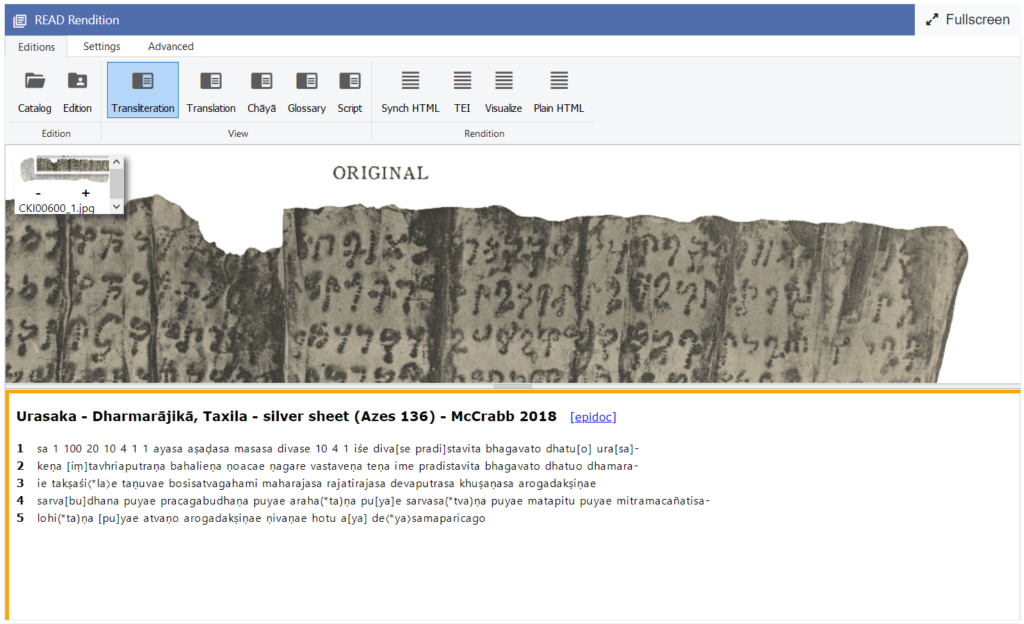Scroll 14 (RS14) of the Robert Senior collection preserves a Gāndhārī extract from the Anavatapta-gāthā (“Songs of Lake Anavatapta”), a compendium of karmic autobiographies spoken by the Buddha’s prominent disciples. Each autobiography presents a complex tapestry of karma, the results of its ripening (Skt. karmavipāka, P kammavipāka) through the speaker’s previous existences, and (in most cases) a crucial event leading the speaker to becoming a disciple of the Buddha Śākyamuni in his present life. The popularity of the Anavatapta-gāthā is indicated by the numerous versions available in Pali, Chinese, Tibetan, and Sanskrit, including Central Asian fragments from Gilgit and Turfanas well as the two Gāndhārī manuscripts held in the Robert Senior and British Library collections. This Senior scroll records the recitation of Mahākāśyapa together with a prologue to the Anavatapta-gāthā. This journal article presents the first digital publication of Senior scroll 14 and includes a diplomatic edition, reconstruction, hybrid edition, translation, Sanskrit chāyā, a glossary, palaeographic report and images. A detailed study of Senior scroll 14 with annotated text edition and parallels was published in Salomon 2008, Gandhāran Buddhist Texts vol. 5.
Item Robert Senior Scroll 14 | Text 1 | Surface r. 1-25, right-hand portion | Material Birch Bark | Size H: 28cm; W: 10cm | Findspot uncertain (presumably Haḍḍa, Afghanistan) | Date approx. 140 CE | Current Location University of Washington, Seattle
Content Summary
The Buddha Śākyamuni flies with his five hundred disciples to Lake Anavatapta and there asks each of them to explain their own karmic histories. Mahākāśyapa then tells how in a past life he gave a handful of millet to a pratyekabuddha and expressed a wish to be associated with such beings in the future. As a result, he was born in the paradisical land of the Kurus a thousand times, and then another thousand times among the thirty-three gods. Finally, he was reborn as a wealthy brahman but rejected the world and met Śākyamuni. Śākyamuni accepted him as a disciple and instructed him for only seven days, after which he attained enlightenment. (Extract from Salomon 2008: 355.)
Keywords
disciple, karma, previous existences
Parallels
- P. Nettippakaraṇa 1-6 (PTS ed. 141.12-142.5)
- Skt. Kaṭhināvadāna § 19a (see Degener 1990: 23-24, 29)
- Skt. Gilgit Bhaiṣajya-vastu of the MūSā Vin folios 199-209, 211-213, 218-219 (see Wille 1990: 70-71, 76-79)
- Ch. Independent translation T 199 at T IV 190a1-202a15 [Dharmarakṣa]
- Ch. Bhaiṣajya-vastu of the MūSā Vin T 1448 at T XXIV 76b29-97a11 [Yijing]
- Tib. Bhaiṣajya-vastu of the MūSā Vin (see Hofinger 1982 [1954]: 34, 46-48)
Companion Publications
- Salomon, Richard. 2008. Two Gāndhārī Manuscripts of the Songs of Lake Anavatapta (Anavatapta-gāthā). British Library Kharoṣṭhī Fragment 1 and Senior Scroll 14. With contributions by Andrew Glass. Gandhāran Buddhist Texts 5. Seattle: University of Washington Press.
- Salomon, Richard. 2018. The Buddhist Literature of Ancient Gandhāra. Part II, translation 5A, pp. 213-15, 219-220. Somerville: Wisdom Publications.
Acknowledgements
The research underlying this project was financially supported by the National Endowment for the Humanities (USA) and the University of Washington’s College of Arts and Sciences. Facilities and general assistance were provided by Department of Asian Languages and Literature, University of Washington. Access to the manuscripts was granted by the British Library and Robert Senior.
Digital publishing by Stephanie Majcher
Each digital edition includes background information about the text, a summary of its content, and references to parallel texts and related publications. Users can explore the text, image, and other analysis resources through various preset views from the READ interface, or customize the views themselves.
By developing the text in READ, the text and image are linked such that selecting a syllable, word, or compound in the text or glossary will highlight the associated akṣaras on the manuscript. This allows you to in effect “read” the manuscript as you read the transcribed text, even if you do not know the script.
Users can choose from several preset READ views by selecting the tabs at the top. Each of these convenient arrangements of text and resources is suited to a different experience with the manuscript. For instance, choose the Script view to study the paleography of the manuscript or the Glossary view to study its vocabulary. It is recommended that the user toggles through the default views to gain a holistic perspective of the text.

- Transliteration: Image and transliteration.
- Translation: Transliteration and translation.
- Chāyā: Transliteration and chāyā.
- Glossary: Image, transliteration, and glossary.
- Script: Image, transliteration, and script chart
- Visualize: Visualize the text structure display.
- Synch HTML: Interactive synchronized rendition.
- TEI: EpiDoc TEI rendition.
- Plain HTML: Transliteration in HTML format.
Avś
Be
Ce
Ch.
CPS
DhG
Ee
FJJ
Mahīś
MūSā
Mvu
P
SĀ
SBhV
Se
Skt.
SN
T
Tib.
Vin
Avadānaśataka (ed. Speyer 1906–1909)
Burmese (Chaṭṭhasaṅgāyana) edition
Sri Lankan (Buddha Jayanti Tipiṭaka Series) edition
Chinese
Catuṣpariṣat-sūtra (ed. Waldschmidt 1952–1962)
Dharmaguptaka
European (Pali Text Society) edition
Fobenxing ji jing (T 190)
Mahīśāsaka
Mūlasarvāstivāda
Mahāvastu-avadāna (ed. Senart 1882–1897)
Pali
Saṃyukta-āgama (T 99)
Saṅghabhedavastu (ed. Gnoli 1977–1978)
Thai (King of Siam) edition
Sanskrit
Saṃyutta-nikāya
Taishō 大正 edition
Tibetan
Vinaya
Cite this article as: Richard Salomon and Stephanie Majcher, “Anavatapta-gāthā” Journal of Gandhāran Buddhist Texts, July 20, 2022, https://gandhari-texts.sydney.edu.au/edition/anavatapta-gatha-sutra.

